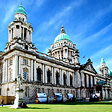CARRICKFERGUS CASTLE
Guarding the Sea Approach on Antrim Coast
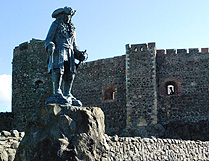 The castle at Carrickfergus is dramatically located at the entrance to the long bay which leads inland to Belfast, its strong stone walls once nearly surrounded by water, and has the distinction of being one of the most assaulted fortresses in Ireland. It has played a role in wars from the Norman conquest of Ireland at the end of the Viking age, an Irish revolt in the Elizabethan era, the Plantation of Ulster and Jacobite-Williamite War, the Napoleonic Wars, and even the American Revolution. One of the best preserved medieval constructions in the Irish Isle, the castle remained in use as a military outpost until the split of Northern Ireland and the Republic when it was turned over by the British Army in 1928 to become a historic monument to 800 years of conflict.
The castle at Carrickfergus is dramatically located at the entrance to the long bay which leads inland to Belfast, its strong stone walls once nearly surrounded by water, and has the distinction of being one of the most assaulted fortresses in Ireland. It has played a role in wars from the Norman conquest of Ireland at the end of the Viking age, an Irish revolt in the Elizabethan era, the Plantation of Ulster and Jacobite-Williamite War, the Napoleonic Wars, and even the American Revolution. One of the best preserved medieval constructions in the Irish Isle, the castle remained in use as a military outpost until the split of Northern Ireland and the Republic when it was turned over by the British Army in 1928 to become a historic monument to 800 years of conflict.
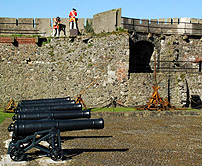 Carrickfergus Castle was first built as a fortress in the early days of the Norman conquest of Ireland. John de Courcy, a knight under the Plantagenet King Henry II marched north in 1176 to take the lands of Ulster, though without the permission of King Henry II. De Courcy established the commanding site at Carrickfergus as his headquarters, beginning the fortress in 1177. De Courcy is responsible for building the inner ward, with a small bailey and the high curtain wall with the eastern gate. De Courcy allied himself through marriage to the Norse by marrying the daughter of King Godred Olofssen of the Isle of Mann. In 1205, under orders from King John, Hugh de Lacey the younger, the son of the Lord of Meath (see Trim Castle), was given the task to take the lands of Ulster which had been granted to the favored de Laceys. De Courcy was accounted to be a fierce warrior and said to sleep in his armor, but de Lacey succeeded in removing him, taking the castle while the erstwhile lord escaped to the sea. De Courcy tried to retake the castle with a force of Norwegian backed men from the Isle of Mann, but the attempt failed. The castle was re-enforced under de Lacey with expansion of the curtain wall to protect from the sea rocks. The features remaining from this period are the Romanesque window of a chapel, the ribbed vault over the entrance passage where a yeoman figure now stands guard, a murder hole” and the massive portcullis protecting the gatehouse.
Carrickfergus Castle was first built as a fortress in the early days of the Norman conquest of Ireland. John de Courcy, a knight under the Plantagenet King Henry II marched north in 1176 to take the lands of Ulster, though without the permission of King Henry II. De Courcy established the commanding site at Carrickfergus as his headquarters, beginning the fortress in 1177. De Courcy is responsible for building the inner ward, with a small bailey and the high curtain wall with the eastern gate. De Courcy allied himself through marriage to the Norse by marrying the daughter of King Godred Olofssen of the Isle of Mann. In 1205, under orders from King John, Hugh de Lacey the younger, the son of the Lord of Meath (see Trim Castle), was given the task to take the lands of Ulster which had been granted to the favored de Laceys. De Courcy was accounted to be a fierce warrior and said to sleep in his armor, but de Lacey succeeded in removing him, taking the castle while the erstwhile lord escaped to the sea. De Courcy tried to retake the castle with a force of Norwegian backed men from the Isle of Mann, but the attempt failed. The castle was re-enforced under de Lacey with expansion of the curtain wall to protect from the sea rocks. The features remaining from this period are the Romanesque window of a chapel, the ribbed vault over the entrance passage where a yeoman figure now stands guard, a murder hole” and the massive portcullis protecting the gatehouse.
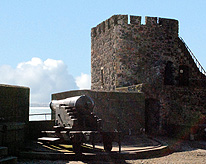 The other substantive features of the castle date from the 16th and 17th centuries, during the age of gunpowder. The castle and the surrounding countryside of present day County Antrim were the site of the Battle of Carrickfergus in 1597, an uprising of the Gaelic MacDonnell clan against the English forces of Queen Elizabeth I, and one hundred years later, the fight for control of the north of Ireland between the Catholic King James II who had been deposed by the Protestant William of Orange. King William III landed in Ireland on the 14th of June 1690 after a successful siege of the castle by his German born commander, General Meinholt Schomberg and went on to end James’ challenge for the crown at the Battle of the Boyne a month later (see Boyne Battlefield). Improvements were made in this period to accommodate artillery, with gunports and embrasures added for cannons on the walls. The cannons are the most notable feature of the remaining historic recreation at the castle. Victorian era living quarters and barracks had been added in the years since, but were removed after the 1930’s to return the castle to its more medieval form.
The other substantive features of the castle date from the 16th and 17th centuries, during the age of gunpowder. The castle and the surrounding countryside of present day County Antrim were the site of the Battle of Carrickfergus in 1597, an uprising of the Gaelic MacDonnell clan against the English forces of Queen Elizabeth I, and one hundred years later, the fight for control of the north of Ireland between the Catholic King James II who had been deposed by the Protestant William of Orange. King William III landed in Ireland on the 14th of June 1690 after a successful siege of the castle by his German born commander, General Meinholt Schomberg and went on to end James’ challenge for the crown at the Battle of the Boyne a month later (see Boyne Battlefield). Improvements were made in this period to accommodate artillery, with gunports and embrasures added for cannons on the walls. The cannons are the most notable feature of the remaining historic recreation at the castle. Victorian era living quarters and barracks had been added in the years since, but were removed after the 1930’s to return the castle to its more medieval form.
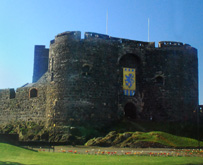 Carrickfergus Castle also curiously played a small role in the American War
for Independence. In 1778, Captain John Paul Jones on patrol off the
North Ireland Coast with his 18 gun sloop, the Ranger, to harass British
shipping, lured a Royal Navy ship-of-the-line, the HMS Drake, from the
channel and engaged in an hour long battle in sight of the castle battlements.
This was the second engagement between the two vessels. The English ship
was captured and delivered to France in the first decisive campaign for
fledgling the American Continental Navy.
Carrickfergus Castle also curiously played a small role in the American War
for Independence. In 1778, Captain John Paul Jones on patrol off the
North Ireland Coast with his 18 gun sloop, the Ranger, to harass British
shipping, lured a Royal Navy ship-of-the-line, the HMS Drake, from the
channel and engaged in an hour long battle in sight of the castle battlements.
This was the second engagement between the two vessels. The English ship
was captured and delivered to France in the first decisive campaign for
fledgling the American Continental Navy.
For more photos see Favorite Castles in Ireland and Northern Ireland.
Visiting Carrickfergus Castle
Carrickfergus Castle is about a 15 minute drive from downtown Belfast and the beginning of the Antrim Coast scenic driving route (see Dunluce Castle Antrim Coast). The castle is open daily from 10am to 6pm April through September and 10am to 4 pm from October to March. Admission is £5 for adults, £3 for kids and seniors. Children under 4 are free. And a Family Ticket is available for £13. Last admission is 30 minutes before closing. © Bargain Travel Europe
Find best travel deals in Northern Ireland on TripAdvisor
Web
Info
Carrickfergus Castle
These articles are copyrighted and the sole property of Bargain Travel Europe and WLPV, LLC. and may not be copied or reprinted without permission.
SEE ALSO:
CARRICK-A-REDE & FISHERMAN’S COTTAGE
GAME OF THRONES LOCATIONS TOUR

